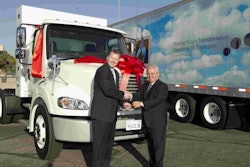A panel of carrier executives discussing the driver shortage said “it’s going to get tough, it’s going to get harder,” and that the current situation is “tough enough that it’s going to threaten the viability of some companies.”
The “Finding Drivers in an Increasingly Tough Market” panel discussion – held Wednesday, Nov. 9, at the CCJ Fall Symposium at the Montelucia Resort and Spa in Phoenix – included Tom Kretsinger, president of American Central Transport; Rob Newell, vice president of capacity development for FFE Transportation; Scott Barker, vice president of safety, recruiting and driver services for Swift Transportation; and Darrel Wilson, chief executive officer for Wil-Trans.
Kretsinger said ACT is seeing an increasing shortfall in driver quality. “We’re spending more money on recruiting and driver pay, but we’re seeing a shortfall in qualifications,” he said. Newell described the driver market as the worst he’s seen since 2004, attributing the problem to the Federal Motor Carrier Safety Administration’s Compliance Safety Accountability oversight regime and tougher qualification requirements.
FFE recently made a strategic decision to open its own driver academy. “We’re going to have to grow our own,” Newell said. The company also is working with owner-operators “to show them how to make more money,” he said. “We’re really careful on how we spend our ad dollars. Our carriers want us to find drivers and grow capacity – it’s very challenging. The owner-operators that are out there are hunkering down – they’re really careful about their CSA scores.”
Wilson said Wil-Trans recently launched a new Website to boost recruiting and is working on more innovative recruiting and marketing efforts to win drivers. Barker said that while Swift gets plenty of applicants, the quality of those applicants has made it more difficult to hire them. “We’re not going to loosen up our hiring criteria,” he said. “We’ve rebranded our recruiting effort. We haven’t had empty trucks so far. We’ve been blessed – it’s attributable to a lot of luck and a lot we’re doing.”
As far as looming regulations regarding hours of service and electronic onboard recorders, Barker said CSA is merely “a new package to the same rules and criteria, but now the public gets to see it.” People can go online and find that Swift had 37,000 inspections in the last two years, but they don’t realize it took 16,000 drivers about 1.6 billion miles to reach that total, he said.
Newell said drivers are looking for carriers with good CSA scores because “they don’t want to get dragged down” by the company’s issues. Kretsinger said drivers interviewing with ACT tell his company they left their previous carrier because it had “really old equipment and they were having a lot of inspections.” Wilson said some Wil-Trans drivers actually have requested EOBRs to keep track of their compliance.
Kretsinger said changes to the hours rules would take flexibility away, and Newell and Barker both said their long-haul companies would have to look into slip-seating drivers. “They’re used to running hard, and EOBRs constrict their flexibility,” Newell said. “It’s going to require training to get drivers to realize how to be productive under the new rules. I see it as a retention challenge going forward.” Wilson said the uncertainty of the pending rulings is hurting recruiting.
Regarding detention, Kretsinger said ACT is “finding out what lanes are tight, and we’re going to the customer and asking why.” Barker said that “firing a customer is not an easy decision to be taken lightly.” FFE monitors dwell time by customer, and “some shippers come around, or we tell them we’re going to have to move to more productive lanes,” Newell said. Wilson said that Wil-Trans drivers taking breaks on customer lots “has helped our compliance greatly.”
As far as recruiting new entrants to relieve the aging driver population, Kretsinger said ACT has developed its Activate program to recruit military personnel, but he asked “How do you get new kids in?” Newell said that while FFE is “trying to sell the idea that it’s a great way to make a living,” the industry is “going to have to start trimming length of hauls – get these folks home more often.” The next generation of extremely technology-savvy prospects poses another interesting challenge, he said. “All the technology you can put in the truck that’s good for the carrier and the driver is good.”
Barker said trucking as a whole has to “frame the industry into a meaningful career field – then I think we’d have a better chance to recruit 23-year-olds. I don’t understand the mentality, but 23-year-olds would rather text than get on the phone, so we have to understand the technology and talk to them in a way they understand.” Wilson said talking to prospects “when they’re 20 years old is not too early. We stay in touch with them until they’re qualified.”
Driver pay and incentives will have to improve, panelists agreed, but a company’s culture also is critical to retention efforts. “Take a look at your culture as the leader of your company – you as the leader have to set the example,” Kretsinger said. Newell added that “It’s a cultural shift from the top to the bottom – we’re all working for the driver. Make them feel important to the company.”
Wilson said “This is a relationship business. I treat them like friends.” Barker said Swift’s 60-odd nationwide recruiters have to be upfront with driver candidates about the job’s difficulties.











